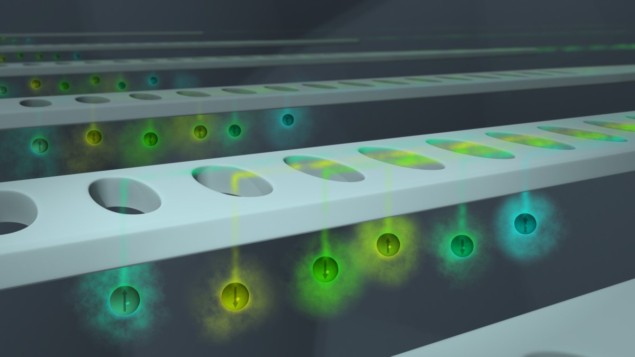
The spin states of entangled erbium ions in a solid crystal can be controlled and read out individually using a new technique developed by Jeff Thompson and colleagues at Princeton University in the US. In doing so, the team has overcome the important challenge of making measurements on closely spaced ions in a crystal. Their technique could lead to the creation of new quantum devices that could be integrated with existing optical telecommunications technology.
Some atomic-scale impurities in solid-state crystals have spins states that endure for long periods of time and can therefore be used as quantum bits (qubits) of information. If the impurities are located close enough together in a crystal, their spins will become entangled with each other. This entanglement can be exploited to create quantum logic gates for quantum computers.
However, the nanoscale separation required for entanglement is typically well below the diffraction limit of visible light. This means that the optical lasers used to control and read out spin states cannot normally distinguish between the spins of individual impurities.
Random shift
One promising way around this problem is to use the rare-earth ions of erbium as impurities. Their spins can retain quantum information over long periods of time and they interact with light at wavelengths used for optical telecommunications. But most importantly, each erbium-ion impurity in a crystal experiences a random static shift in its optical transition energies. This means that even if the positions of multiple ions cannot be resolved spatially, their spin states can be controlled and read-out using the distinct wavelengths of the light they absorb and emit when illuminated by a laser.

Nanodiamond quantum thermometer measures the temperature of worms
To exploit this property, Thompson’s team doped a yttrium orthosilicate crystal with erbium ions. They then coupled the system to a photonic silicon cavity, which enhances the emission of light from the ions and makes it easier to read out the spins. Out of hundreds of erbium ions in the sample, the researchers focused on six ions in a sub-micron region, tuning the wavelength of a laser to match each of the ions. This approach allowed them to easily control and read out the spin states of individual ions with high fidelity.
Thompson and colleagues now hope that their approach can be scaled up to accommodate large numbers of rare earth ions with arbitrarily small separations – making them suitable for multiple-qubit systems. Crucially, they point out that the technology could be easily integrated into existing communications infrastructures: transmitting encoded signals in telecommunications frequency bands using present-day silicon devices and optical fibres. If achieved, this could soon allow erbium ion defects to provide a solid basis for future quantum computers, as well as ultra-secure quantum communication networks.
The research is described in Science.



